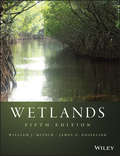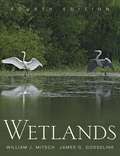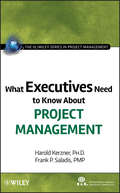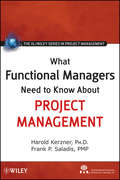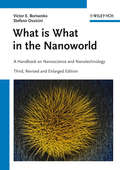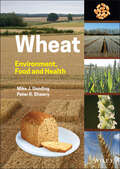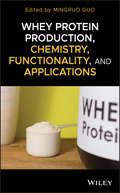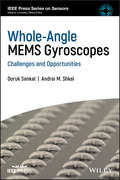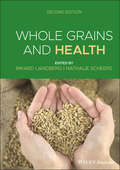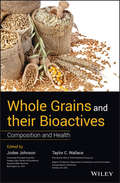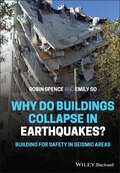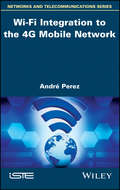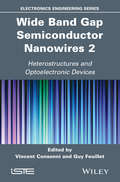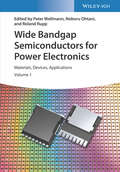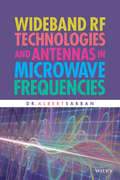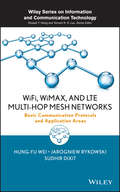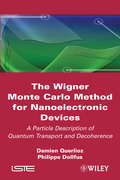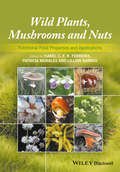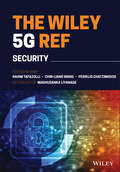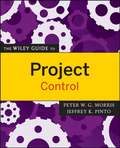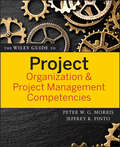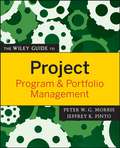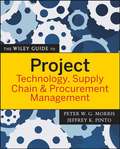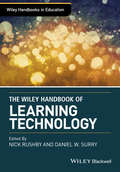- Table View
- List View
Wetlands: Structure And Function, Management And Methods
by William J. Mitsch James G. GosselinkThe single most important book on wetlands, newly expanded and updated Wetlands is the definitive guide to this fragile ecosystem, providing the most comprehensive coverage and in-depth information available in print. Recently updated and expanded, this latest edition contains brand new information on Wetland Ecosystem Services and an updated discussion on Wetland, Carbon, and Climate Change and Wetland Creation and Restoration. Due to popular demand, the authors have brought back five streamlined chapters on wetland ecosystems that had been removed from previous editions, and provided more robust ancillary materials including an online color photo gallery, PowerPoint slides, and several video case studies. As nature's kidneys, wetland ecosystems help the environment process toxins and excess fertilizers and maintain the relative health of our aquatic ecosystems. As the understanding of their importance grows, their management and ecology have gained increased attention and have become an area of professional specialization over the past two decades. This book gives readers a solid understanding of wetlands, how they work, what they do, and why the Earth can't live without them. Understand wetlands' role in the ecosystem, from local to global scales Appreciate the fact that wetlands may be the most logical and economical way to sequester carbon from the atmosphere Discover the unique characteristics that make wetlands critically important for improving water quality, reducing storm and flood damage, and providing habitat to support biodiversity Learn how wetlands are being managed or destroyed around the globe but also how we can create and restore them Examine the ways in which climate change is affecting wetland ecosystems and wetland ecosystems affect climate change Wetlands are crucial to the health of the planet, and we've only begun to realize the magnitude of the damage that has already been done as we scramble to save them. A generation of ecologists, ecological engineers, land use planners, and water resource managers worldwide owe their knowledge of the wetlands to this book – for the next generation to follow in their footsteps, Wetlands 5th edition is the quintessential guide to these critical systems.
Wetlands
by James G. Gosselink William J. MitschPraise for the previous editions of Wetlands:"Wetlands, the field of study, would not be what it is without Wetlands, the book."----Bill Streever, Wetlands, 2001"The Third Edition of this highly successful book manages to set new standards in presentation and content to confirm its place as the first point of reference for those working or studying wetlands."----Chris Bradley, University of Birmingham, UK, Regulated Rivers: Research and Management"This book is the wetlands bible...the most wide-ranging [book] on the subject."----Carl Folke, Royal Swedish Academy of Sciences, Land Use Policy"The single best combination text and reference book on wetland ecology."----Joseph S. Larson, University of Massachusetts, Journal of Environmental Quality"First on my list of references to recommend to someone new to wetland policy management or science."----Jay A. Leitch, North Dakota State University, Water Resources BulletinFor more than two decades, William Mitsch and James Gosselink's Wetlands has been the premier reference on wetlands for ecologists, land use planners, and water resource managers worldwide--a comprehensive compendium of the state of knowledge in wetland science, management, and restoration.Now Mitsch and Gosselink bring their classic book up to date with substantial new information and a streamlined text supplemented with a support web site. This new Fourth Edition maintains the authoritative quality of its predecessors while offering such revisions as:Refocused coverage on the three main parts of the book: 1. An introduction to the extent, definitions, and general features of wetlands of the world; 2. Wetland science; and 3. Wetland management.New chapter on climate change and wetlands that introduces the student to the roles that wetlands have in climate change and impact that climate change has on wetlands.Increased international coverage, including wetlands of Mexico and Central America, the Congolian Swamp and Sine Saloum Delta of Africa, the Western Siberian Lowlands, the Mesopotamian Marshland restoration in Iraq, and the wetland parks of Asia such as Xixi National Wetland Park in eastern China and Gandau Nature Park in Taipei, Taiwan. This expanded coverage is illustrated with over 50 wetland photographs from around the world.Several hundred new refer?ences for further reading, up-to-date data, and the latest research findings.Over 35 new info boxes and sidebars provide essential background information to concepts being presented and case studies of wetland restoration and treatment in practice.
What Executives Need to Know About Project Management
by International Institute for Learning Frank P. Saladis Harold R. KerznerDiscover how executives can apply the Kerzner Approach® to improve project managementAs an executive today, you need to become more involved in project management. That doesn't mean you need to become a project manager, but rather you need to know how to set the stage for a project's success, oversee its execution, and intervene directly at key strategic moments. Here's the book that gives you everything you need to know about your role in project management clearly and succinctly.Based on principles set forth in the bestselling Project Management: A Systems Approach to Planning, Scheduling, and Controlling, Tenth Edition, this easy-to-follow guide focuses on the pivotal role you play as an executive in project management. It introduces the acclaimed Kerzner Approach®, demonstrating how it empowers you with the skills needed to ensure that projects are completed successfully, on time, and on budget.The International Institute for Learning/Wiley Series in Project Management features the most innovative, tested-and-proven approaches to project management, all explained in clear, straightforward language. The series offers new perspectives on solving tough project management problems as well as practical tools for getting the job done. Each book in the series is drawn from the related IIL course and is written by noted project management experts.
What Functional Managers Need to Know About Project Management
by Frank P. Saladis Harold R. Kerzner International Institute for LearningDiscover how functional managers can apply the Kerzner Approach to project managementAs a functional manager today, you need to become more involved in project management. That doesn't mean you need to become a project manager, but rather you need to know how to perform specific project-related tasks, work with project team members, understand each other's priorities and problems, and resolve issues jointly. Now here's the book that gives you everything you need to know about your role in project management clearly and succinctly.Based on principles set forth in the bestselling Project Management: A Systems Approach to Planning, Scheduling, and Controlling, Tenth Edition, this easy-to-follow guide focuses on the pivotal role you play as an executive in project management. It introduces the acclaimed Kerzner Approach, demonstrating how it empowers functional managers with the skills needed to ensure that projects are completed successfully, on time, and on budget.The International Institute for Learning/Wiley Series in Project Management features the most innovative, tested-and-proven approaches to project management, all explained in clear, straightforward language. The series offers new perspectives on solving tough project management problems as well as practical tools for getting the job done. Each book in the series is drawn from the related IIL course and is written by noted project management experts.
What is What in the Nanoworld
by Victor E. Borisenko Stefano OssiciniThe third, partly revised and enlarged edition of this introductory reference summarizes the terms and definitions, most important phenomena, and regulations occurring in the physics, chemistry, technology, and application of nanostructures. A representative collection of fundamental terms and definitions from quantum physics and chemistry, special mathematics, organic and inorganic chemistry, solid state physics, material science and technology accompanies recommended secondary sources for an extended study of any given subject.Each of the more than 2,200 entries, from a few sentences to a page in length, interprets the term or definition in question and briefly presents the main features of the phenomena behind it. Additional information in the form of notes ("First described in", "Recognition", "More details in") supplements the entries and gives a historical perspective of the subject with reference to further sources.Ideal for answering questions related to unknown terms and definitions among undergraduate and PhD students studying the physics of low-dimensional structures, nanoelectronics, and nanotechnology.
Wheat: Environment, Food and Health
by Mike J. Gooding Peter R. ShewryWheat is produced on a greater area, grown over a wider geographic range, and traded internationally as a commodity more than any other arable crop. Wheat alone provides 20% of the calories and protein in the global human diet. Understanding the interactions between wheat production, the environment, and human nutrition is essential for meeting the demands of food security as we approach the middle of the 21st century. Wheat: Environment, Food and Health is written by two leading authorities in the field and offers insights into critical issues such as the sustainability of wheat production, the challenges of both mitigating and adapting to environmental change, and the effects of wheat consumption on human health. Covering a broad range of topics, the authors: Introduce the historical development and utilization of the wheat crop. Describe the factors affecting the quality and acceptability of wheat for different uses. Discuss the soil characteristics that are required for, and changed by, wheat production. Examine the water, temperature, and light requirements of wheat systems. Explore the methods and sustainability of plant breeding and farmer approaches to improving crop yields. Describe the development, structure, and composition of wheat grain. Discuss the contribution and impacts, both positive and negative, of wheat consumption on human health. • Discuss how modern technologies and new approaches are addressing the challenges of maintaining wheat production. Wheat: Environment, Food and Health is an essential resource for researchers and academics in disciplines including agriculture, plant biology, applied biology, botany, food science and nutrition, crop improvement, food security, environmental sustainability, and human health.
Whey Protein Production, Chemistry, Functionality, and Applications
by Mingruo GuoAn up-to-date overview of the dynamic field of whey protein utilization Whey Protein Production, Chemistry, Functionality and Applications explores the science and technology behind the rapidly increasing popularity of this most versatile of dairy by-products. With its richly nutritious qualities, whey protein has been widely used in the food industry for many years. The last decade has, however, seen manufacturers develop many innovative and exciting new applications for it, both in food and other areas. Taking account of these advances, this insightful work offers a full explanation of the technological and chemical breakthroughs that have made whey protein more in-demand than ever before. Topics covered include manufacturing technologies, thermal and chemical modifications, non-food uses, denaturation and interactions, and more. In its broad scope, the book encompasses: An up-to-date overview of recent developments and new applications Breakdowns of the chemical, nutritional, and functional properties of whey protein Commentary on the current and future outlooks of the whey protein market Examinations of the methods and manufacturing technologies that enable whey protein recovery A full guide to the numerous applications of whey protein in food production and other industries Whey Protein Production, Chemistry, Functionality and Applications is an unparalleled source of information on this highly adaptable and much sought-after commodity, and is essential reading for food and dairy scientists, researchers and graduate students, and professionals working in the food formulation and dairy processing industries.
Whole-Angle MEMS Gyroscopes: Challenges and Opportunities (IEEE Press Series on Sensors)
by Doruk Senkal Andrei M. ShkelPresents the mathematical framework, technical language, and control systems know-how needed to design, develop, and instrument micro-scale whole-angle gyroscopes This comprehensive reference covers the technical fundamentals, mathematical framework, and common control strategies for degenerate mode gyroscopes, which are used in high-precision navigation applications. It explores various energy loss mechanisms and the effect of structural imperfections, along with requirements for continuous rate integrating gyroscope operation. It also provides information on the fabrication of MEMS whole-angle gyroscopes and the best methods of sustaining oscillations. Whole-Angle Gyroscopes: Challenges and Opportunities begins with a brief overview of the two main types of Coriolis Vibratory Gyroscopes (CVGs): non-degenerate mode gyroscopes and degenerate mode gyroscopes. It then introduces readers to the Foucault Pendulum analogy and a review of MEMS whole angle mode gyroscope development. Chapters cover: dynamics of whole-angle coriolis vibratory gyroscopes; fabrication of whole-angle coriolis vibratory gyroscopes; energy loss mechanisms of coriolis vibratory gyroscopes; and control strategies for whole-angle coriolis vibratory gyro- scopes. The book finishes with a chapter on conventionally machined micro-machined gyroscopes, followed by one on micro-wineglass gyroscopes. In addition, the book: Lowers barrier to entry for aspiring scientists and engineers by providing a solid understanding of the fundamentals and control strategies of degenerate mode gyroscopes Organizes mode-matched mechanical gyroscopes based on three classifications: wine-glass, ring/disk, and mass spring mechanical elements Includes case studies on conventionally micro-machined and 3-D micro-machined gyroscopes Whole-Angle Gyroscopes is an ideal book for researchers, scientists, engineers, and college/graduate students involved in the technology. It will also be of great benefit to engineers in control systems, MEMS production, electronics, and semi-conductors who work with inertial sensors.
Whole Grains and Health
by Rikard Landberg Nathalie ScheersWHOLE GRAINS AND HEALTH The updated guide to whole grains and their integral role in nutritional healthIn an increasingly health-conscious society, the potential benefits of whole grain products are of paramount importance to manufacturers, dieticians, and consumers alike. Whole Grains and Health covers all aspects of this crucial topic, presenting a data-driven study of whole grains’ functional components, associated biomarkers and overall impact upon human health. Now in its second edition, the text has been revised and expanded to include six new chapters and groundbreaking new data. This essential guide features:Summaries of large research projects on the health effects of whole grain in Europe and the USNew data on the associations between whole grain consumption and risk of developing chronic diseases Discussions of metabolomics and their use in addressing health effects and finding new biomarkers of both dietary exposure and health effects related to the diet Information on the use of genomics in studies of how gene-expression profiles change in response to whole grain intake Newly identified bioactive compounds in whole grains and whole grain fractions The new EU regulations on health claims that affect whole grain food products Providing information that will be of interest to food scientists, healthcare specialists and food industry professionals alike, the second edition of Whole Grains and Health is an essential resource for anyone concerned with the impact whole grains may have upon health.
Whole Grains and their Bioactives: Composition and Health
by Taylor C. Wallace Jodee JohnsonA review of various types of whole grains, the bioactives present within them, and their health-promoting effects As rates of obesity and other chronic conditions continue to rise, so too does the need for clear and accurate information on the connections between diet and disease, particularly regarding the cereal grains that dominate the Western diet. In this volume, editors Jodee Johnson and Taylor Wallace assemble a panel of leading experts to address this issue. The result is a comprehensive examination of the cereal and pseudo-cereal grains and their most important bioactive compounds. Not only does this volume offer summaries of existing research, it also places these findings within the larger context of health promotion and disease prevention. This includes frank discussions on the limitations of existing studies, as well as current gaps in research for those who want to offer evidence-based recommendations to their patients. Topics addressed include: Methodical analyses of domesticated grain species, their horticultural history, nutritional composition, and known effects on health Beneficial properties of certain bioactive compounds found in particular grain species How bioactive compounds work within an individual’s overall diet to increase health and prevent disease Academic and industry researchers, as well as medical practitioners and public health professionals, will appreciate Whole Grains and their Bioactives, not only as an engaging overview of current research, but also as an illuminating contribution to the often-murky debate surrounding health and the human diet.
Why do buildings collapse in earthquakes? Building for safety in seismic areas
by Robin Spence Emily SoLearn from the personal experience and insights of leading earthquake engineering specialists as they examine the lessons from disasters of the last 30 years and propose a path to earthquake safety worldwide Why Do Buildings Collapse in Earthquakes?: Building for Safety in Seismic Areas delivers an insightful and comprehensive analysis of the key lessons taught by building failures during earthquakes around the world. The book uses empirical evidence to describe the successes of earthquake engineering and disaster preparedness, as well as the failures that may have had tragic consequences. Readers will learn what makes buildings in earthquake zones vulnerable, what can be done to design, build and maintain those buildings to reduce or eliminate that vulnerability, and what can be done to protect building occupants. Those who are responsible for the lives and safety of building occupants and visitors - architects, designers, engineers, and building owners or managers - will learn how to provide adequate safety in earthquake zones. The text offers useful and accessible answers to anyone interested in natural disasters generally and those who have specific concerns about the impact of earthquakes on the built environment. Readers will benefit from the inclusion of: A thorough introduction to how buildings have behaved in earthquakes, including a description of the world’s most lethal earthquakes and the fatality trend over time An exploration of how buildings are constructed around the world, including considerations of the impact of climate and seismicity on home design A discussion of what happens during an earthquake, including the types and levels of ground motion, landslides, tsunamis, and sequential effects, and how different types of buildings tend to behave in response to those phenomena What different stakeholders can do to improve the earthquake safety of their buildings The owners and managers of buildings in earthquake zones and those responsible for the safety of people who occupy or visit them will find Why Do Buildings Collapse in Earthquakes? Building for Safety in Seismic Areas essential reading, as will all architects, designers and engineers who design or refurbish buildings in earthquake zones.
Wi-Fi Integration to the 4G Mobile Network
by Andre PerezThe adoption of smartphones has had as a corollary the use of services that require streaming, such as video streaming, which is a constraint for the 4G mobile network. The integration of the network of Wi-Fi hotspots deployed by the operators adds capacity to the 4G mobile network.The use of Wi-Fi technology in carrier networks is the result of developments coordinated by the IEEE, WFA and WBA standardization bodies. For its part, the 3GPP standardization body has been working to integrate Wi-Fi technology into the 4G mobile network.The first part of this book presents the characteristics of the Wi-Fi radio interface. The different IEEE 802.11b / g / n / ac physical layers characterize the implementation in the 2.4 GHz ISM frequency bands and U- NII at 5 GHz. The MAC layer defines a number of media access procedures such as scanning, associating, or transferring data.The second part of this book deals with the architecture of the 4G network based on the Wi-Fi interface. This architecture defines several models corresponding, on the one hand, to Wi-Fi access controlled or not, On the other hand, to a handover controlled by the network or by the mobile. The integration of Wi-Fi technology resulted in a redefinition of attachment and session set-up procedures.Smartphones have the ability to activate simultaneously the two radio interfaces, LTE and Wi-Fi, which allows to direct certain services to one and / or the other of the interfaces. The ANDSF and HotSpot 2.0 functions provide the mobile with rules for network selection and traffic control to determine which traffic is to be routed to what type of interface.
Wide Band Gap Semiconductor Nanowires 2: Heterostructures and Optoelectronic Devices (Wiley-iste Ser.)
by Robert BaptistThis book, the second of two volumes, describes heterostructures and optoelectronic devices made from GaN and ZnO nanowires. Over the last decade, the number of publications on GaN and ZnO nanowires has grown exponentially, in particular for their potential optical applications in LEDs, lasers, UV detectors or solar cells. So far, such applications are still in their infancy, which we analyze as being mostly due to a lack of understanding and control of the growth of nanowires and related heterostructures. Furthermore, dealing with two different but related semiconductors such as ZnO and GaN, but also with different chemical and physical synthesis methods, will bring valuable comparisons in order to gain a general approach for the growth of wide band gap nanowires applied to optical devices
Wide Bandgap Nanowires: Synthesis, Properties, and Applications
by Tuan Anh Pham Toan Dinh Nam-Trung Nguyen Hoang-Phuong PhanWIDE BANDGAP NANOWIRES Comprehensive resource covering the synthesis, properties, and applications of wide bandgap nanowires This book presents first-hand knowledge on wide bandgap nanowires for sensor and energy applications. Taking a multidisciplinary approach, it brings together the materials science, physics and engineering aspects of wide bandgap nanowires, an area in which research has been accelerating dramatically in the past decade. Written by four well-qualified authors who have significant experience in the field, sample topics covered within the work include: Nanotechnology-enabled fabrication of wide bandgap nanowires, covering bottom-up, top-down and hybrid approaches Electrical, mechanical, optical, and thermal properties of wide bandgap nanowires, which are the basis for realizing sensor and energy device applications Measurement of electrical conductivity and fundamental electrical properties of nanowires Applications of nanowires, such as in flame sensors, biological sensors, and environmental monitoring For materials scientists, electrical engineers and professionals involved in the semiconductor industry, this book serves as a completely comprehensive resource to understand the topic of wide bandgap nanowires and how they can be successfully used in practical applications.
Wide Bandgap Semiconductors for Power Electronics: Materials, Devices, Applications
by Peter WellmannWide Bandgap Semiconductors for Power Electronic A guide to the field of wide bandgap semiconductor technology Wide Bandgap Semiconductors for Power Electronics is a comprehensive and authoritative guide to wide bandgap materials silicon carbide, gallium nitride, diamond and gallium(III) oxide. With contributions from an international panel of experts, the book offers detailed coverage of the growth of these materials, their characterization, and how they are used in a variety of power electronics devices such as transistors and diodes and in the areas of quantum information and hybrid electric vehicles. The book is filled with the most recent developments in the burgeoning field of wide bandgap semiconductor technology and includes information from cutting-edge semiconductor companies as well as material from leading universities and research institutions. By taking both scholarly and industrial perspectives, the book is designed to be a useful resource for scientists, academics, and corporate researchers and developers. This important book: Presents a review of wide bandgap materials and recent developments Links the high potential of wide bandgap semiconductors with the technological implementation capabilities Offers a unique combination of academic and industrial perspectives Meets the demand for a resource that addresses wide bandgap materials in a comprehensive manner Written for materials scientists, semiconductor physicists, electrical engineers, Wide Bandgap Semiconductors for Power Electronics provides a state of the art guide to the technology and application of SiC and related wide bandgap materials.
Wideband RF Technologies and Antennas in Microwave Frequencies
by Dr Albert SabbanPresents wideband RF technologies and antennas in the microwave band and millimeter-wave band This book provides an up-to-date introduction to the technologies, design, and test procedures of RF components and systems at microwave frequencies. The book begins with a review of the elementary electromagnetics and antenna topics needed for students and engineers with no basic background in electromagnetic and antenna theory. These introductory chapters will allow readers to study and understand the basic design principles and features of RF and communication systems for communications and medical applications. After this introduction, the author examines MIC, MMIC, MEMS, and LTCC technologies. The text will also present information on meta-materials, design of microwave and mm wave systems, along with a look at microwave and mm wave receivers, transmitters and antennas. Discusses printed antennas for wireless communication systems and wearable antennas for communications and medical applications Presents design considerations with both computed and measured results of RF communication modules and CAD tools Includes end-of-chapter problems and exercises Wideband RF Technologies and Antennas in Microwave Frequencies is designed to help electrical engineers and undergraduate students to understand basic communication and RF systems definition, electromagnetic and antennas theory and fundamentals with minimum integral and differential equations. Albert Sabban, PhD, is a Senior Researcher and Lecturer at Ort Braude College Karmiel Israel. Dr. Sabban was RF and antenna specialist at communication and Biomedical Hi-tech Companies. He designed wearable compact antennas to medical systems. From 1976 to 2007, Dr. Albert Sabban worked as a senior R&D scientist and project leader in RAFAEL.
WiFi, WiMAX and LTE Multi-hop Mesh Networks
by Hung-Yu Wei Sudhir Dixit Jarogniew RykowskiWifi, WiMAX, and Cellular Multihop Networks presents an overview of WiFi-based and WiMAX-based multihop relay networks. As the first text to cover IEEE 802.16j multihop hop relay technology, this revolutionary resource explores the latest advances in multi-hop and ad-hoc networking. Not only does this reference provide the technological aspects, but also the applications for the emerging technology and architectural issues. Ranging from introductory material to advanced topics, this guidebook, plus PowerPoint slides, is essential for engineers, researchers, and students interested in learning more about WiFi and WiMAX multihop relay networks.
The Wigner Monte Carlo Method for Nanoelectronic Devices: A Particle Description of Quantum Transport and Decoherence (Wiley-iste Ser.)
by Damien Querlioz Philippe DollfusThis book gives an overview of the quantum transport approaches for nanodevices and focuses on the Wigner formalism. It details the implementation of a particle-based Monte Carlo solution of the Wigner transport equation and how the technique is applied to typical devices exhibiting quantum phenomena, such as the resonant tunnelling diode, the ultra-short silicon MOSFET and the carbon nanotube transistor. In the final part, decoherence theory is used to explain the emergence of the semi-classical transport in nanodevices.
Wild Plants, Mushrooms and Nuts: Functional Food Properties and Applications
by Isabel C. Ferreira Patricia Morales Lillian BarrosWild Plants, Mushrooms and Nuts: Functional Properties and Food Applications is a compendium of current and novel research on the chemistry, biochemistry, nutritional and pharmaceutical value of traditional food products, namely wild mushrooms, plants and nuts, which are becoming more relevant in diets, and are especially useful for developing novel health foods and in modern natural food therapies. Topics covered will range from their nutritional value, chemical and biochemical characterization, to their multifunctional applications as food with beneficial effects on health, though their biological and pharmacological properties (antioxidant, antibacterial, antifungal, antitumor capacity, among others).
The Wiley 5G REF: Security
by Rahim Tafazolli Chin-Liang Wang Periklis Chatzimisios Madhusanka LiyanageFrom the Section Editor’s Foreword by Dr. Madhusanka Liyanage, University College Dublin, Ireland. The Wiley 5G Ref: Security offers a stellar collection of articles selected from the online-only Work, The Wiley 5G Reference. It aims to provide a solid educational foundation for researchers and practitioners in the field of 5G Security and Privacy to expand their knowledge base by including the latest developments in these disciplines. The book introduces the security landscape of 5G, and significant security and privacy risks associated with the 5G networks. Then, the security solutions for different segments of the 5G network, i.e., radio network, edge network, access network, and core network, are discussed. Since 5G is developed based on network softwarization, security threats associated with key network softwarization technologies such as SDN, NFV, NS, and MEC are also presented in detail. Then, the security issues related to the new 5G and IoT services are delivered. Finally, a detailed discussion on the privacy of 5G networks is presented by considering Datafied Society. Written by leading experts in security and privacy for the telecommunication network, this book is intended to provide additional learning opportunities for a wide range of readers, from graduate-level students to seasoned engineering professionals. We are confident that this book and the entire collection of selected articles will continue Wiley’s tradition of excellence in technical publishing and provide a lasting and positive contribution to the teaching and practice of security and privacy of 5G and beyond networks.
The Wiley Guide to Project Control (The Wiley Guides to the Management of Projects #9)
by Peter Morris Jeffrey K. PintoTimely and accessible content on the traditional project management activities of control, risk, time and cost, and quality and value The Wiley Guides to the Management of Projects address critical, need-to-know information that will help professionals successfully manage projects in most businesses and help students learn the best practices of the industry. They contain not only well-known and widely used basic project management practices but also the newest and most cutting-edge concepts in the broader theory and practice of managing projects. This second book in the series explains the "traditional" project management activities of control, risk, time, cost, and quality. The expert contributors show that project control represents more than the simple evaluation of project performance. They detail the principles of project time and cost control and offer a detailed review of critical chain project management. In addition, they provide a framework for project performance measurement, show how to make risk management more effective, and tell how to improve quality management. Touching on all of the fundamental levers of project control, this book will prove to be a comprehensive "owner's manual" for project and team managers, project team members, engineers, business consultants, and all those involved in any aspect of project management. Complete your understanding of project management with these other books in The Wiley Guides to the Management of Projects series: * The Wiley Guide to Project Organization & Project Management Competencies * The Wiley Guide to Project Technology, Supply Chain & Procurement Management * The Wiley Guide to Project, Program & Portfolio Management
The Wiley Guide to Project Organization and Project Management Competencies (The Wiley Guides to the Management of Projects #8)
by Peter Morris Jeffrey K. PintoA guide to the human factors in project management: knowledge, learning, and maturity The Wiley Guides to the Management of Projects address critical, need-to-know information that will help professionals successfully manage projects in most businesses and help students learn the best practices of the industry. They contain not only well-known and widely used basic project management practices but also the newest and most cutting-edge concepts in the broader theory and practice of managing projects. This third volume in the series covers a range of organizational and people-based topics that are occupying the project management world today. The essence of project management represents a "people" challenge-the ability to appreciate and effectively employ the competencies of all those who are associated with the project development and delivery process. This book explains how you can more successfully manage a project from inception through delivery by learning how to handle critical issues around structure, teams, leadership, power and negotiation, and the whole area of competencies. The expert contributors also include chapters on global project management knowledge and standards, the role of project management associations around the world, project management maturity models, and other key topics. Complete your understanding of project management with these other books in The Wiley Guides to the Management of Projects series: * The Wiley Guide to Project Control * The Wiley Guide to Project, Program & Portfolio Management * The Wiley Guide to Project Technology, Supply Chain & Procurement Management
The Wiley Guide to Project, Program, and Portfolio Management (The Wiley Guides to the Management of Projects #10)
by Peter Morris Jeffrey K. PintoA comprehensive guide to project management and its interaction with other management systems and strategies The Wiley Guides to the Management of Projects address critical, need-to-know information that will enable professionals to successfully manage projects in most businesses and help students learn the best practices of the industry. They contain not only well-known and widely used basic project management practices but also the newest and most cutting-edge concepts in the broader theory and practice of managing projects. This first book in the series, The Wiley Guide to Project, Program & Portfolio Management, is based on the "meta" level of management, which, simply stated, asserts that project management must be integrated throughout an organization in order to achieve its full potential to enhance the bottom line. This book will show you how to fully understand and exploit the strategic management of projects, portfolios, and program management and their linkage with context and strategy in other concepts and processes, such as quality management, concurrent engineering, just-in-time delivery, systems management and engineering, teams, and statistical quality control. Featuring contributions from experts all around the world, this invaluable resource book offers authoritative project management applications for industry, service businesses, and government agencies. Complete your understanding of project management with these other books in The Wiley Guides to the Management of Projects series: * The Wiley Guide to Project Control * The Wiley Guide to Project Organization & Project Management Competencies * The Wiley Guide to Project Technology, Supply Chain & Procurement Management
The Wiley Guide to Project Technology, Supply Chain, and Procurement Management (The Wiley Guides to the Management of Projects #7)
by Peter W. G. Morris Jeffrey K. PintoA complete guide to managing technical issues and procuring third-party resources The Wiley Guides to the Management of Projects address critical, need-to-know information that will help professionals successfully manage projects in most businesses and help students learn the best practices of the industry. They contain not only well-known and widely used basic project management practices but also the newest and most cutting-edge concepts in the broader theory and practice of managing projects. This fourth volume in the series offers expert guidance on the supply chain and delivery cycle of the project, as well as the technology management issues that are involved such as modeling, design, and verification. Technology within the context of the management of projects involves not so much actually doing the "technical" elements of the project as managing the processes and practices by which projects are transformed from concepts into actual entities-and doing this effectively within the time, cost, strategic, and other constraints on the project. The contributors to this volume, among the most recognized international leaders in the field, guide you through the key life-cycle issues that define the project, ensure its viability, manage requirements, and track changes-highlighting the key steps along the way in transforming and realizing the technical definition of the project. Complete your understanding of project management with these other books in The Wiley Guides to the Management of Projects series: * The Wiley Guide to Project Control * The Wiley Guide to Project, Program & Portfolio Management * The Wiley Guide to Project Organization & Project Management Competencies
The Wiley Handbook of Learning Technology (Wiley Handbooks in Education)
by Nick Rushby Daniel W. SurryThe Wiley Handbook of Learning Technology is an authoritative and up-to-date survey of the fast-growing field of learning technology, from its foundational theories and practices to its challenges, trends, and future developments. Offers an examination of learning technology that is equal parts theoretical and practical, covering both the technology of learning and the use of technology in learning Individual chapters tackle timely and controversial subjects, such as gaming and simulation, security, lifelong learning, distance education, learning across educational settings, and the research agenda Designed to serve as a point of entry for learning technology novices, a comprehensive reference for scholars and researchers, and a practical guide for education and training practitioners Includes 29 original and comprehensively referenced essays written by leading experts in instructional and educational technology from around the world
